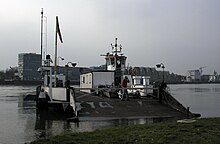Bingerbrück (ship)
|
||||||||||
|
||||||||||
|
||||||||||
The Bingerbrück was built in 1966 as a car ferry by the Hans Boost shipyard in Trier .
history
The Bingerbrück was used as a car ferry on the Rhine and Moselle from 1966 to 1976 . In 1976 the Bingen Waterways and Shipping Authority took over the ferry and had it converted into a sounding ship. In 2002 the ship went to the Cologne Waterways and Shipping Authority . The equipment was modified to adapt the technology to the requirements of the time. In June 2014, the Bingerbrück was decommissioned and offered for sale through Vebeg .
technology
The ship was 44.95 m long, 11.53 m wide and had a draft of 1.30 m. The drive took place via four Schottel rudder propellers using four Deutz diesel engines of type "BF 6m 1013E" with an output of 110 kW each. The control stand on the starboard side was designed as a one-man control stand and had two control panels offset by 90 °. This arrangement gave the skipper the necessary overview even when traveling across the river.
The bearing system was a multiple transducer system that consisted of 41 individual transducers . These were mounted on the long side on a vibrating bridge, each one meter apart and 0.60 m immersion depth. This made it possible to create a sounding carpet 40 m wide. With this technology, the Bingerbrück was one of the best sounding ships on European inland waterways.
In order to ensure the function of the bow and stern flaps, the swing bridge could be hydraulically swiveled 90 degrees over a length of eight meters. The Schwinger Bridge was designed and built by the Lülsdorf shipyard in Niederkassel .
The additional equipment included two location systems that work independently of one another. On the open road, the position and height were determined with an RTK - GPS (Real Time Kinematic-Global Positioning System). In areas with strong shadowing, such as in the area of bridges, the position and height measurement was carried out with a rotating laser type Polartrack from ATLAS Hydrographic. The daily bearing capacity was 300,000 m², which corresponds to about one kilometer of water. The bearings could be made in longitudinal or transverse direction.

